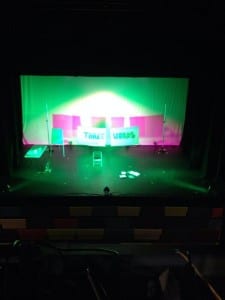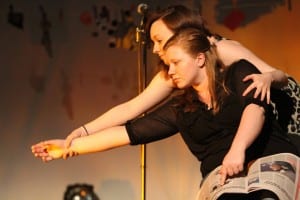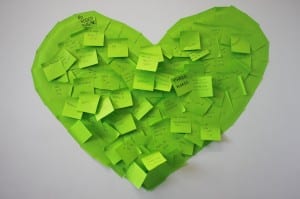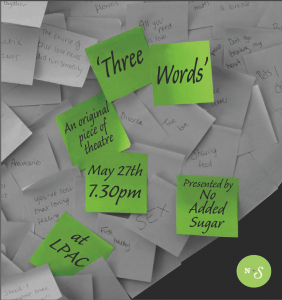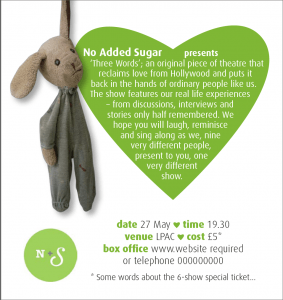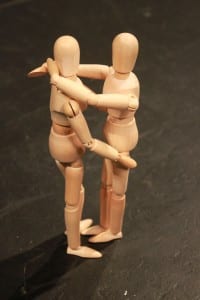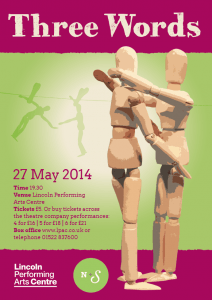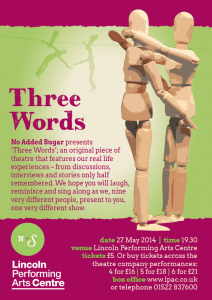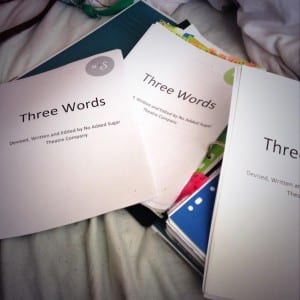
As Stage Manager for the company, it was decided – between myself, Abbi and Tom – that whilst doing our tech in the space for Three Words it would only be necessary for the three of us to be there. We then arranged a space for the other 6 members of our company to rehearse, do line runs and also rehearse harmonies for songs. This was a good plan as during our tech it allowed us to focus and get things moving along quite nicely. Not to offend any of the company but I feel that had they been present things would have been completed at a slower pace, this would mainly have been due to curiosity and wonder as to what was happening. These are things which I felt could be self explanatory when we do a run in the space with tech.
So for our tech session Abbi had created a schedule which allowed for our time to spent wisely, allowing us to communicate effectively with the in house technicians, Alex, Martin and Darren which made for an easier get in for all individuals involved. We utilised our previous skills and made sure that everyone was doing something helpful in order to do tasks as quick, but effectively, as we could.
Abbi, as well as being our Production Manager, is also our lighting designer. So as she explained her vision to the technicians and what lights she wanted to use to create the effects and spaces on stage, we all began to get a clear understanding of the task ahead. It was then time to focus the lights onto the spaces. Today was only a rough focus for us to gain an idea of what it will look like. It shall be focused more on the performance day. Today Abbi made her vision come to life, and it was magical… And as Abbi says We are not adding sugar but we are certainly adding colour. Here is a little sneaky preview of our preset 🙂
Having a acquired a good understanding of QLab it meant that myself and Abbi had put together a QLab file ready for the tech. I then grouped the cue together to allow for easier operation. I had a fun job of colour coding each cue to match what was in my folder. This was a good thing to know how to do so that I can easily tell where we are in the show just by the colours that were with the cue that we would currently be in. This helps me not to panic as much for operating the show. I have operated several shows over my time but never have I operated one on stage whilst performing. This in itself is a challenge so I have grouped the cues into scenes and gave them colours, yellow – lighting, green – AV, pink – sound.
The QLab file just needed a few final adjustments and it was soon performance ready. Martin, was impressed with the standard that it was up to, but this had been made through the training that he himself had taught me over the previous year.
As Abbi was programming the lighting with Alex, me and Tom had the chance to talk about sound with Martin, who will be mixing our sound levels for us live during the show. I had not realised that there would be so much that needed to be done regarding sound. This understanding means I have to alter our performance day schedule that I had created, I am not sure how this will go down with the cast but I am sure they will cope. Talking it through with Martin helped us to know how it was going to work on the day, and how he is going to work and what he needs from us on the performance day.
Overall I feel like today has been a success, we achieved what was set on our schedule. The three of us and the technicians, we all became one team and, worked effectively communicating with one another. I feel now as though it is real and we have a performance. It is amazing how much the technical aspects of a show can bring it to life. So with 5 days to go… I am feel confident with the overall process, as I know I have amazing technicians behind me and also a wonderful cast to perform alongside.
